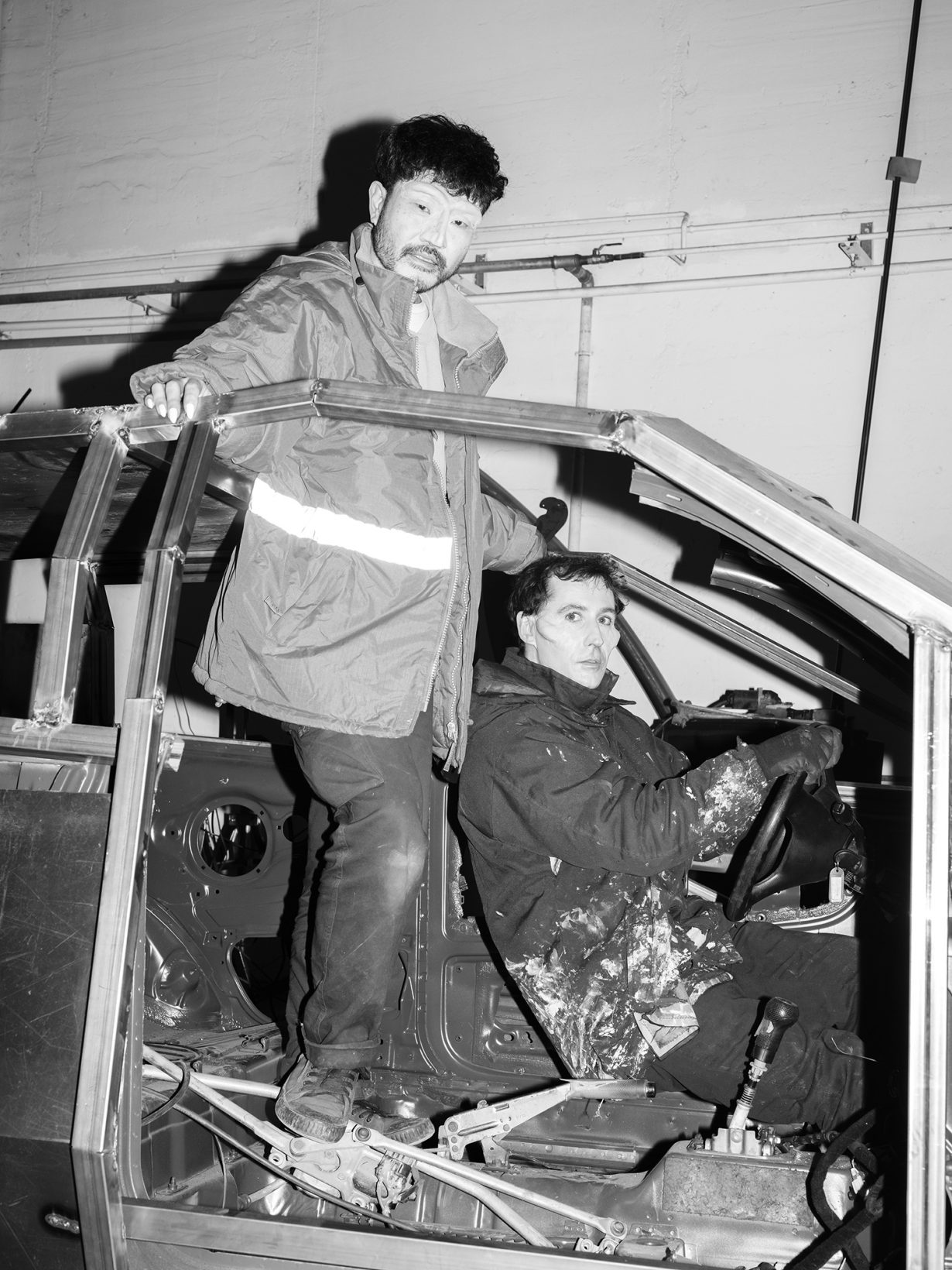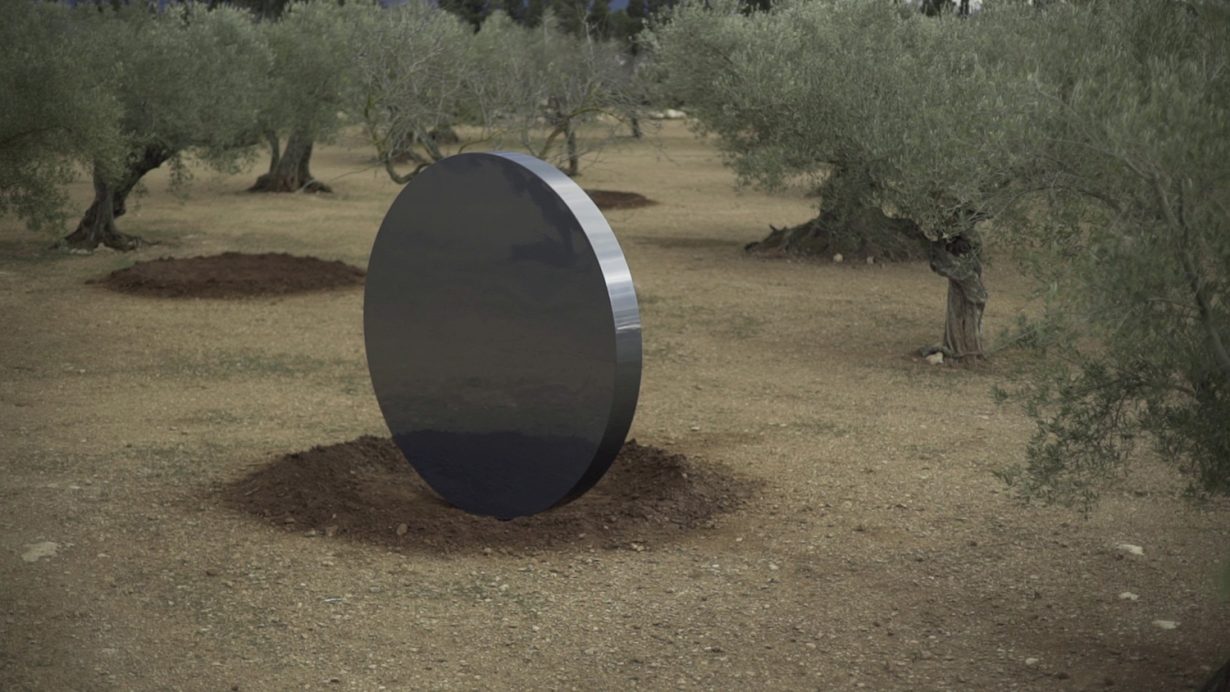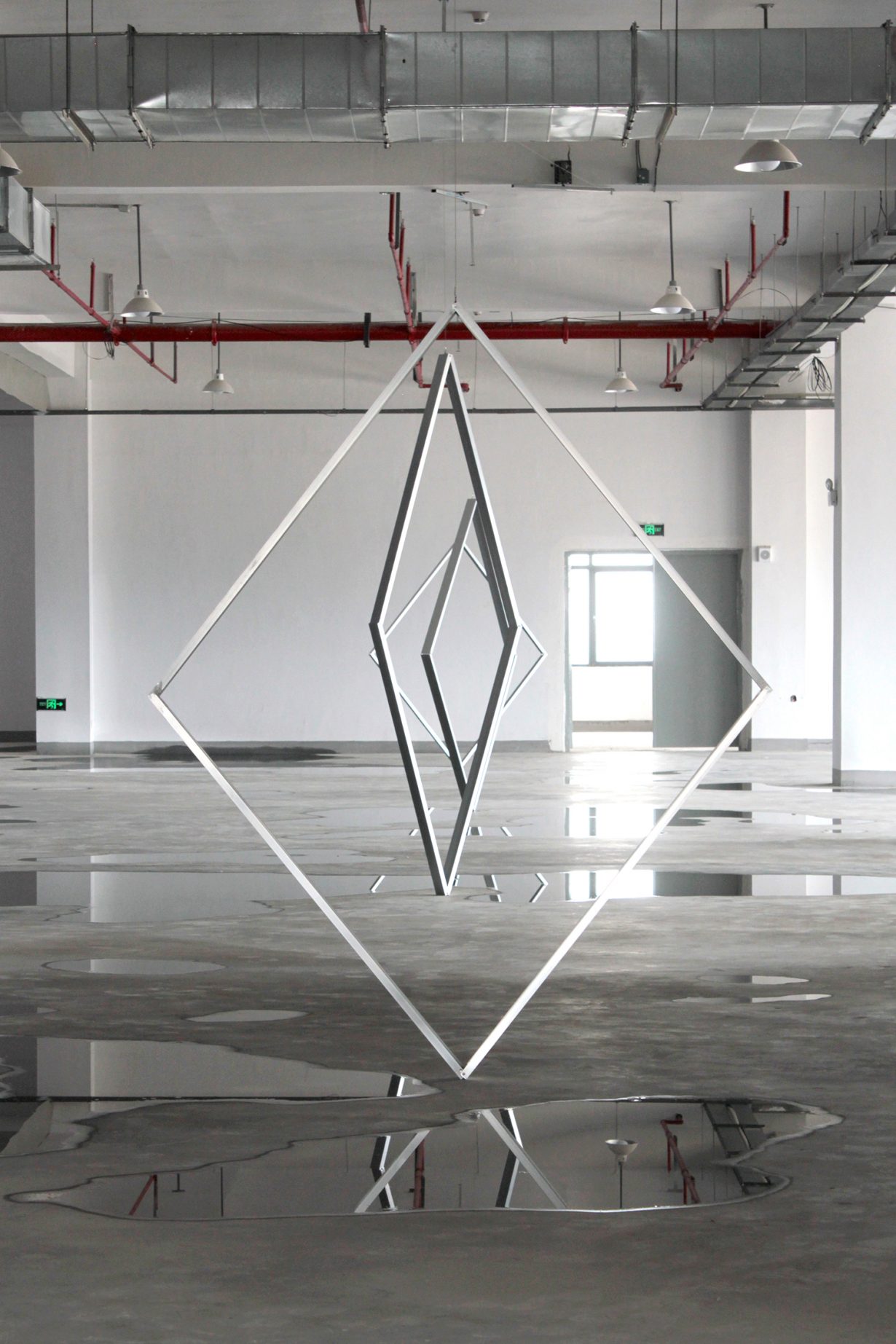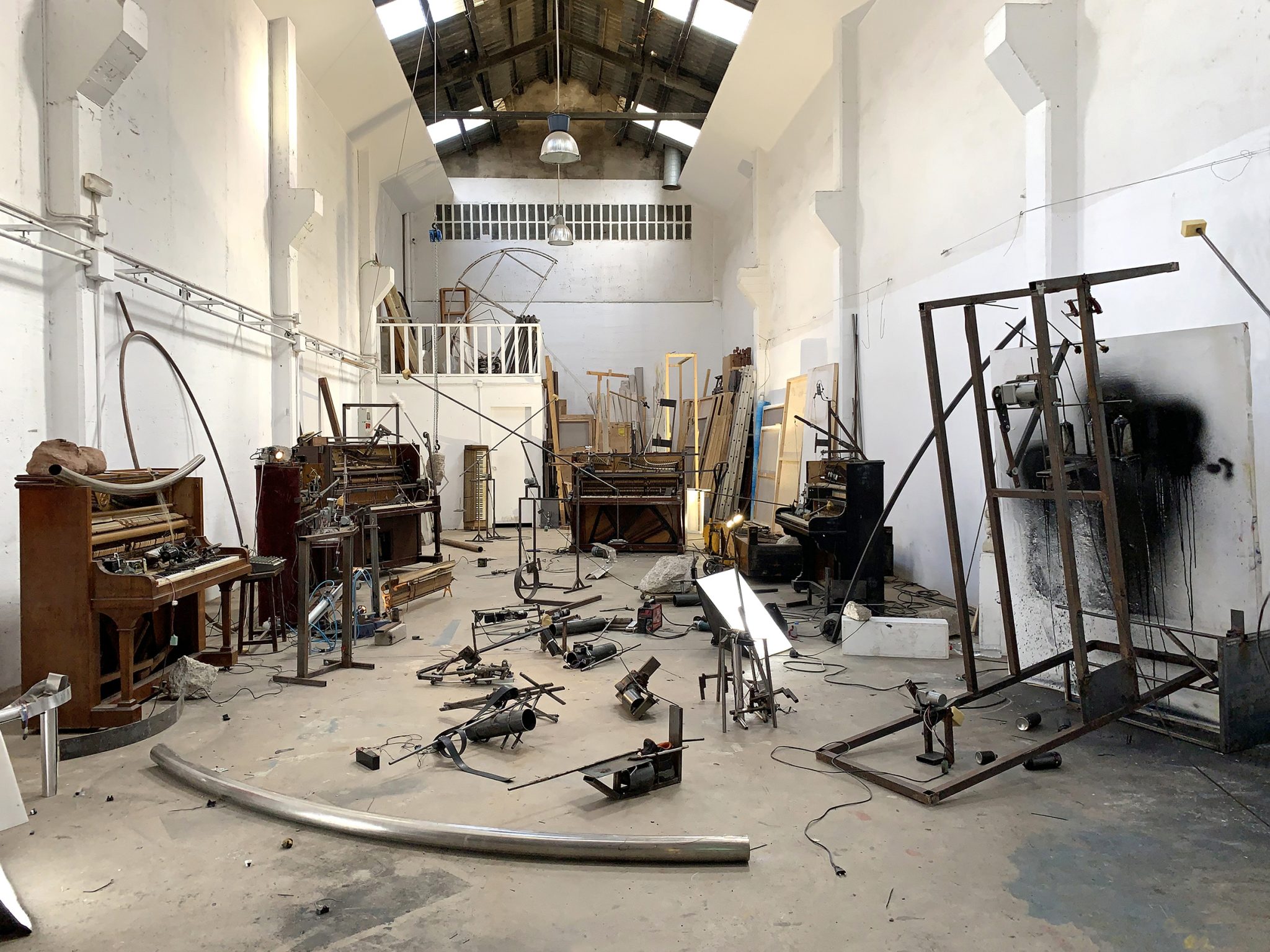“We have a lot of feelings with them, but some of them are very cold and they don’t even look at us. They don’t know we are there”
After failed attempts at painting and video art, the Barcelona-based duo Lolo & Sosaku eventually began exhibiting as a sound project in 2006. With machines and motors, they produced a sonic world that recalled noise and industrial and Lou Reed’s contentious 1975 album Metal Machine Music. These tracks are rich in timbral diversity: engines hum, instruments are methodically destroyed, tension hangs on taut wire strings. More recently, though, the duo have begun aiming their machines at canvases. In their Barcelona studio, small spinning robots stab away at paintings like brainless elves, scribbling with the wobble of a baby’s motor skills. These are analogue creatures from the era of mechanical industry, made of wood and alloy, wires and pistons, tape and nails.
To create their work, Lolo & Sosaku let the machines go about their business, occasionally adjusting them. One machine waddles to the right until it gets stuck and repeatedly slaps away at a corner, accumulating paint. Another wanders off to the far side of the studio. Still another crawls across the length of a painting, dragging a tenuous line. When the moment is right, Lolo or Sosaku steps in to interrupt, sending the devices off on a new streak of mark making. These motoric instruments are sculptural beings in themselves. Full of character, they thrum away constantly, just as we do: a ticking heart, breathing lungs, the regular tides of the nervous system. They live to work, and work to make art.
On the phone, I spoke to Lolo, but not to Sosaku, whom Lolo describes as “shy” and resistant to interviews. Lolo is used to speaking for Sosaku, whose intentions he understands well after almost two decades of collaborating. In all our exchanges around this interview, Lolo was enthusiastically warm – ‘hugs’ in every email – and he continuously apologised for his poor understanding of English (his first language is Spanish). When we spoke, Lolo had just returned from a vacation to San Sebastián, and, as was apparent from the playful sounds in the background, had recently become a father.

A Crack in Time
Ross Simonini Has fatherhood changed your relationship to being an artist?
Lolo No, it’s the same, actually. I think it’s – it’s more powerful. Yesterday my daughter was a bit sick and I was at home with her. But I do a lot of work from the phone and emails then. The days you cannot go to the studio, you can make drawings or think about things. But you cannot stop creating. This compulsion is something you have or you don’t have. If you have it, you are fucked.
RS Do you feel that way? Like it’s a curse?
L No, no. I was joking.
RS But a little bit, right?
L Yeah. You have to sacrifice a lot. You have to make terrible decisions about money and risks. And if you are really confident you take the risk always. And this is very dangerous. But Sosaku and I have taken the risk many times, and for many years we were super broke. For three years we were sleeping in a small studio room together, and then suddenly it started to go well.
RS When did that change for you?
L It’s still happening. But we are always spending our whole commission budgets and also our personal fee to make the pieces better.
RS Did you turn towards painting as a way of selling more work?
L Our last exhibition in Italy, we sold paintings, but we are not successful artists. This is not our goal. Our goal is just to do what we want. When we are in the studio, we always think we are not in this timeline. This is where we want to be. We imagine a crack in our timeline and inside this crack there are things happening. It is really not happening in the present for us. Like in our piece Disco [2018, a disc-shaped sculptural installation in Catalonia’s Ebro Delta] – these things we take from another time, from this crack, from all time and space. It always happens the same: the images come.
RS How would you describe this place?
L Totally noisy. And mechanical and logical. There are no humans. There are water sounds, motor sounds and plants growing very slowly, but no humans in that place. It is not about the future or past.
RS A parallel time.
L We figured this place out in 2018.

Less Than Great
RS When did you start collaborating with Sosaku?
L In 2004. We were experimenting with sound but we did not release anything.
RS So you started as a band?
L We actually started with painting but that was horrible. Because I have my line and Sosaku has his line – each one of us has one style. You can recognise everyone’s drawing. So we started to do some videos in festivals. But that was also a little bit not good. Then we started to do sound for the movies. And then we experimented with just the sound and this became our place where we don’t have any background. I don’t know anything about music, and Sosaku knows a little bit, enough to play guitar, but super badly. In sound, we have an immense white canvas to do whatever we want and experiment fully.
RS Were you playing with traditional instruments at this point?
L If you play with normal instruments or computers or samples, you have to really build your instruments and skills to find new sounds. So we started to build some instruments, just by looks. We were doing installations and festivals, and we got very tired because we needed 24 hours at least to set up and four hours for soundcheck. It was not easy.
And then we started to imagine other things that relate to the movement but not sound. This is how our work started happening in the edges. It’s not like a proper discipline – what we are doing is actually happening at the edge of disciplines. With the painting machines project, we have sculptures making a painting, but we are changing them in a performance.
RS You’re collaborating with your creation.
L You kind of get in the way. And in a way, this is also video art, because we use these videos of these performances in exhibitions. We are like the mechanics for the artist machines.
RS And you have the tilted car sculpture [Torque, 2022, Alegria Gallery, Barcelona] in a recent show, which seems like a direct reference to that.
L Exactly.
RS Was there sound coming from that car?
L In the beginning, yes. But we took it out. There were originally three machines hitting the car from inside and from the top.
RS So how did the new paintings come to be?
L We started a few years ago with this project and we didn’t like the paintings. We did 50 or 60. They were horrible. We liked the process, but the painting itself was no good.
RS But you liked the paintings that you eventually did show in 2019?
L Yeah. The painting has to transmit energy, vibration, the composition has to be nice. Many things have to happen to make a good painting, but in our case many paintings fail, because we are not totally controlling the process.

Repairing with Love
RS Since you use motors, everything is about the motion of spinning all the time. You have to contain that.
L Yeah, the whole universe is spinning. It’s the natural, the right way, how a motor works. Even at the level of elementary particles, the very small level, everything is always spinning. In the beginning we were working with pendulums, because we like natural forces. People think we do nothing but make machines, but we are near during the whole process. We choose the colours, we choose the composition.
RS There’s a sense in your work that over time you’re sort of merging with the machines. Is that how it feels to you?
L Yeah, in the future when I start to fail, my knees or my legs or whatever, I would love to put on a mechanic arm, a mechanic leg. I would love to have a mechanical part of myself, fingers or whatever.
RS You admire industrial-era machines, but you aren’t dipping into newer technologies, like CGI.
L You know, we understand how these machines work, but artificial intelligence – we really don’t understand how that works. We like to see and touch the thing. We like the motors, to touch the motors. We like to work with our hands. We are kind of artists from the twentieth century. I love AI, but we don’t use it because we don’t understand it.
RS Do you feel a connection with the machines? They each seem to have a personality.
L We have a lot of feelings with them, but some of them are very cold and they don’t even look at us. They don’t know we are there. But some are beautiful and very kind. Some are very funny. Sometimes they don’t want to work. They go around the studio and sometimes one breaks and we repair it with love, and sometimes without love, and change it. We used 22 machines for one painting once and changed the machines during the process – adding arms, taking out arms, adding legs, adding a very long thing, making something new appear.
RS Are you –
L One writer asked us what we really like most. Sosaku said insects, I said trees. And then she said, but this doesn’t relate to your work? But in our work there is transformation. There is change. There is growing. Trees are open to change without their control, and insects are very similar to machines: it looks like they don’t have feelings. They don’t have expression in the faces. They also are transforming. Many of them change colours or change totally, as butterflies do.

RS But industrial music and the philosophy around that was also attractive to you growing up.
L Yeah. My father likes cars, and my little brother does too. I like the smell of oil and gasoline, and Sosaku was into technology because he is from Japan, where they lead the way with technology. I was born in Argentina. But somehow we were both fans of the Japanese series Evangelion.
RS I thought of the movie Tetsuo: The Iron Man [1989] when I saw your work.
L Yes. We love it. Yeah. I like how he had a car accident and then from there he started to mix himself up with metal. Perfect.
RS Are you building a science-fictional world in this way?
L A few years ago, we started to realise that something like this is going on. But we need more time. Our work is basically investigation – investigation of movement and shapes – but something is building up there. You are right. We are starting to see it, slowly. We just need more time to be always following the mystery.
Ross Simonini is a writer, artist, musician and dialogist. He is the host of ArtReview’s podcast Subject, Object, Verb
